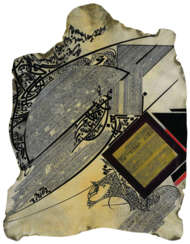тунис



Pyotr Tarasovych Maltsev (Russian: Пётр Тарасович Мальцев) was a distinguished Soviet artist, celebrated for his mastery in socialist realism. Born on December 17, 1907, in Mariupol, Maltsev carved a niche for himself in the art world through his profound works that often depicted the valor and spirit of the Soviet people during significant historical events. His art education was rooted in the traditions of the Zaporozhe Art School and further honed at the VKhUTEIN, under the guidance of notable Soviet artists such as P.V. Kuznetsov and V.A. Favorsky.
Maltsev's oeuvre includes a plethora of works ranging from paintings and posters to monumental dioramas, with notable pieces like “The Storm of Sapun Ridge,” which vividly captures the intensity of the Battle of Sevastopol. His art, imbued with the ethos of socialist realism, strives to embody the heroism and resilience of the Soviet populace amidst the trials of war and the pursuit of socialism.
His contributions to Soviet art were not only recognized by his contemporaries but continue to be revered today, with many of his works being housed in prestigious institutions such as the State Tretyakov Gallery and the Central Naval Museum. Maltsev's legacy extends beyond the canvas, encapsulating the spirit of an era and continuing to inspire generations. His passing on October 5, 1993, marked the end of a remarkable chapter in Soviet art history, but his works live on, offering a window into the Soviet soul and its indomitable will.
For collectors and experts in art and antiques, Maltsev's body of work presents a unique insight into the Soviet aesthetic and ideological landscape. To stay updated on new product sales and auction events related to Pyotr Tarasovych Maltsev, subscribing for updates is highly recommended. This subscription ensures that enthusiasts are well-informed of the latest developments and opportunities to engage with Maltsev's enduring legacy.



Nadia Kaabi-Linke is a Tunis-born, Berlin-based visual artist best known for her conceptual art and 2011 sculpture Flying Carpets. Her work has explored themes of geopolitics, immigration, and transnational identities. Raised between Tunis, Kyiv, Dubai and Paris, she studied at the Tunis Institute of Fine Arts and received a Ph.D. in philosophy of art from the Sorbonne. Kaabi-Linke won the 2011 Abraaj Group Art Prize, which commissioned Flying Carpets, a hanging cage-like sculpture that casts geometric shadows onto the floor akin to the carpets of Venetian street vendors. The piece was acquired by the New York Guggenheim in 2016 as part of their Guggenheim UBS MAP Global Art Initiative. Kaabi-Linke also won the Discoveries Prize for emerging art at the 2014 Art Basel Hong Kong. Her works have been collected by the Museum of Modern Art, Dallas Museum of Art, Burger Collection, and Samdani Art Foundation, and exhibited in multiple solo and group shows.


Nadia Kaabi-Linke is a Tunis-born, Berlin-based visual artist best known for her conceptual art and 2011 sculpture Flying Carpets. Her work has explored themes of geopolitics, immigration, and transnational identities. Raised between Tunis, Kyiv, Dubai and Paris, she studied at the Tunis Institute of Fine Arts and received a Ph.D. in philosophy of art from the Sorbonne. Kaabi-Linke won the 2011 Abraaj Group Art Prize, which commissioned Flying Carpets, a hanging cage-like sculpture that casts geometric shadows onto the floor akin to the carpets of Venetian street vendors. The piece was acquired by the New York Guggenheim in 2016 as part of their Guggenheim UBS MAP Global Art Initiative. Kaabi-Linke also won the Discoveries Prize for emerging art at the 2014 Art Basel Hong Kong. Her works have been collected by the Museum of Modern Art, Dallas Museum of Art, Burger Collection, and Samdani Art Foundation, and exhibited in multiple solo and group shows.


Nadia Kaabi-Linke is a Tunis-born, Berlin-based visual artist best known for her conceptual art and 2011 sculpture Flying Carpets. Her work has explored themes of geopolitics, immigration, and transnational identities. Raised between Tunis, Kyiv, Dubai and Paris, she studied at the Tunis Institute of Fine Arts and received a Ph.D. in philosophy of art from the Sorbonne. Kaabi-Linke won the 2011 Abraaj Group Art Prize, which commissioned Flying Carpets, a hanging cage-like sculpture that casts geometric shadows onto the floor akin to the carpets of Venetian street vendors. The piece was acquired by the New York Guggenheim in 2016 as part of their Guggenheim UBS MAP Global Art Initiative. Kaabi-Linke also won the Discoveries Prize for emerging art at the 2014 Art Basel Hong Kong. Her works have been collected by the Museum of Modern Art, Dallas Museum of Art, Burger Collection, and Samdani Art Foundation, and exhibited in multiple solo and group shows.





![Плутарх. Плутарховы сравнительные жизнеописания славных мужей: [в 13 ч.] / Пер. с греческого Спиридон Дестунис; с историч. и критич. примеч., с геогр. картами и изображениями славных мужей.](/assets/image/picture_4216330/9e5fd/rnttrqe4jldgxra0mqbcatibqw1sea0rbznaggpx3guogdryb8vnzrwof7el3eq1727023481jpg__fix_374_244.jpeg)
![Плутарх. Плутарховы сравнительные жизнеописания славных мужей: [в 13 ч.] / Пер. с греческого Спиридон Дестунис; с историч. и критич. примеч., с геогр. картами и изображениями славных мужей.](https://veryimportantlot.com/assets/image/picture_4216330/9e5fd/rnttrqe4jldgxra0mqbcatibqw1sea0rbznaggpx3guogdryb8vnzrwof7el3eq1727023481jpg__fix_374_244.jpeg)










































